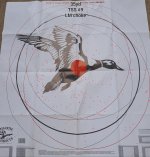Here's the data on the Hevi loads.
12 GA HEVI Bismuth loads
I cut open five shells, from the same box as the shells to be patterned, and the components (powder and shot) were weighed, counted, and measured for consistency. Here are my findings from those dissections.
12 GA 2 ¾" HEVI-Bismuth load
1 ¼ oz #5 Bi (228 pellets) @ 1400 fps
PELLET COUNT / WEIGHT (grains) (1 ¼ ounce = 546.9 gr)
234 / 497.0 gr
231 / 491.2 gr
228 / 484.6 gr
227 / 485.8 gr
222 / 468.5 gr
Aver. 228.4 / 485.42 gr + flax seeds 12.68 gr
PELLET SIZE (25 pellets, 5 pellets/shell, #5 pellet dia. = .120”)
.126”, .125”, .124”, .124”, .123”, .122”, .121”, .120”, .119”, .119”, .119”, .118”, .116”, .115”, .115”, .114”, .113”, .112”, .112”, .111”, .110”, .109”, .107”, .096”, .093”
Aver. .11532” dia.
POWDER / SHELL (grains)
33.8 gr
33.7 gr
33.5 gr
33.4 gr
33.4 gr
Aver. 33.56 gr
PATTERNING RESULTS
The patterns were shot at 40 yards with a Remington 870 Special Purpose 12-gauge using a 28-inch Rem-choke barrel and factory flush Modified Rem-choke, .018-inch constriction from a bore gauge. The 40-yard (muzzle to target) pattern data is the result of pellet hits registered in a 30-inch post-shot inscribed circle from five separate pattern shots.
HEVI-Bismuth load
12ga 2 ¾” 1 ¼ oz #5 Bi (228 pellets)
40 Yards / Modified Rem-choke
Patterns: 99, 97, 81, 74, 72
Aver. 84.6 (37.04%)
12 GA 3" Hevi-Hammer Upland Duplex (bismuth/steel) load
1 3/8 oz #3 Bi (55 pellets) + #3 Steel (126 pellets) = 181 total pellets @ 1350 fps
PELLET COUNT / WEIGHT (grains) (1 3/8 ounce = 601.6 gr)
183 / 568.9 gr
183 / 565.1 gr
181 / 557.3 gr
179 / 545.9 gr
178 / 549.9 gr
Aver. 180.8 / 557.42 gr + flax seeds 16.38gr
(Bi/55.4 + Steel/125.6 = 181 pellets) (Bi/30.6% of payload)
PELLET SIZE (25 pellets, 5 pellets/shell, #3 Bi pellet dia. = .140”)
.149”, .148”, .148”, .146”, .146”, .146”, .145”, .145”, .143”, .143”, .142”, .142”, .141”, .140”, .140”, .140”, .139”, .138”, .138”, .138”, .137”, .137”, .136”, .134”, .131”
Aver. .14128” dia.
PELLET SIZE (25 pellets, 5 pellets/shell, #3 Steel pellet dia. = .140”)
.141”, .141”, .141”, .141”, .141”, .140”, .140”, .140”, .140”, .140”, .140”, .140”, .140”, .140”, .140”, .140”, .139”, .139”, .139”, .139”, .139”, .139”, .139”, .139”, .137”
Aver. .13976” dia.
POWDER / SHELL (grains)
40.0 gr
40.0 gr
39.9 gr
39.4 gr
39.4 gr
Aver. 39.74 gr
PATTERNING RESULTS
The patterns were shot at 40 yards with a Remington 870 Special Purpose 12-gauge using a 28-inch Rem-choke barrel and factory flush Modified Rem-choke, .018-inch constriction from a bore gauge. The 40-yard (muzzle to target) pattern data is the result of pellet hits registered in a 30-inch post-shot inscribed circle from five separate pattern shots.
Hevi-Hammer Upland Bismuth/Steel Duplex load
12ga 3” 1 3/8 oz (Bi/55 + Steel/126 = 181 total pellets)
40 yards / Modified Rem-choke
Patterns: 107, 102, 102, 100, 94
Aver. 101.0 (55.86%)


